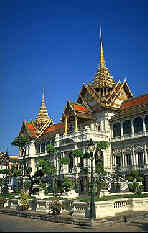

History of Bangkok
Four hundred years ago, Bangkok and Thonburi,
an area on the west bank of the Chao Phraya, were just small villages. At that
time they served as ports for ships sailing up the river to Ayuthaya, the former
capital of what was then called Siam. As ships got larger and the river got
shallower, the villages grew in importance.
The kingdom's capital was relocated to Thonburi
when Ayuthaya fell to Burmese armies in 1767. King Rama I moved the capital
across the river to Bangkok in 1782, because the main Burmese threat to the Thai
came from the west, on the Thonburi side of the river.
Bangkok’s history of the past 200 years is much interwoven with the Chakri
dynasty which still reigns but no longer rules Thailand today. After Chao Phaya
Chakri was crowned under the royal title of Rama I in 1782, one of his
first major decisions concerned his capital.
Bangkok was not really founded by Rama I. It had been a settled area for several hundred years already and it had even been well-known to European merchants who commonly stopped over at Bangkok on their way to Ayutthaya.
Bangkok, as you could already read, is not the true name of the city - it called by the Thais as Krung Thep. This name was bestowed on the place in the year 1782 by King RamaI, the father of the Chakri dynasty. The name means "City of Angels" Ayuthaya in the year 1767 was conquered and almost completely destroyed by the Burmese. Those parts of the Thai army that survived the attack fled south to Thonburi on the banks of the Chao Phraya (Menam). There they established a military headquarter and temporary capital of Siam. From Thonburi, the Thai generals engaged in 15 years of war with the attackers (the Burmese had in the meantime been joined by the Laotians and the Vietnamese) and finally managed to drive them out of the country. After the final victory, General Taksin assumed the throne, but was later executed. He was replaced by General Chakri, who as king took the name of Rama I. The king's plan was to rebuild his people's confidence by building a city that could match Ayuthaya's glory and splendor. He decided that Thonburi was no longer suitable as a royal residence and decided to move the capital to Bangkok on the other side of the river.
 "Bangkok" used to be "plum orchard", and although it sounds quite unbelievable today, that is indeed what it once was
- a small, peaceful village surrounded by wild plum trees. At the time Rama I. decided to move his capital,
it had already grown into a small duty port. The town was mainly inhabited by Chinese merchants and customs inspectors, who were asked to vacate the area and Rama
I started building his new city, beginning with Wat Phra
Kaew (Emerald Buddha). Defensive moats were dug and canals built and a city wall was erected from bricks from the old city wall of
Ayuthaya.
"Bangkok" used to be "plum orchard", and although it sounds quite unbelievable today, that is indeed what it once was
- a small, peaceful village surrounded by wild plum trees. At the time Rama I. decided to move his capital,
it had already grown into a small duty port. The town was mainly inhabited by Chinese merchants and customs inspectors, who were asked to vacate the area and Rama
I started building his new city, beginning with Wat Phra
Kaew (Emerald Buddha). Defensive moats were dug and canals built and a city wall was erected from bricks from the old city wall of
Ayuthaya.
Work on the Grand Palace and the Temple of the Emerald Buddha (Wat Phra Kaew) was by and large completed in 1785. The new capital, now more or less just covering the area on the eastern side of the Chao Phaya.
In the 1850s, the city really was a "Venice of the East" with lots of canals and waterways and only a handful of dusty roads. A city with a large network of water-roads in the place of streets, and intersected with bridges. A large proportion of its inhabitants lived in floating houses, which line both banks of the Menam (Chao Phaya river)
King Mongkut (Rama IV.) and then his son King Chulalongkorn (Rama V.) pursued the modernization of the country added roads and built railways. The city continued to grow in all directions through the 19th and 20th centuries, eventually encompassing Thonburi. In the 20th century the city started growing both eastward and towards north. The first bridge over the Chao Phraya river (Memorial Bridge) was built in 1932. In the Second World War, the city was occupied by the Japanese. The 1950s was a period of political turmoil , with several coup d'etats. The 1960s saw, due to the Vietnam war, the beginning of the economic rise of Thailand, which has only now, in the 90s come to a halt. Bangkok's population increased by about 1 million people between the 1980 and 1990 censuses alone. But still, the economic and social conditions are far better than in many of the neighboring countries in Southeast Asia.
Copyright © 2000 - 2002 HelloSiam.com All rights reserved.